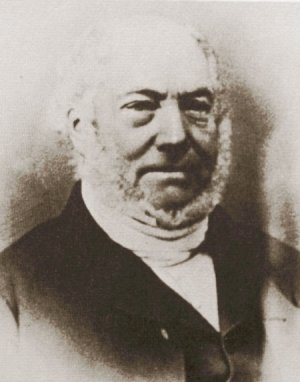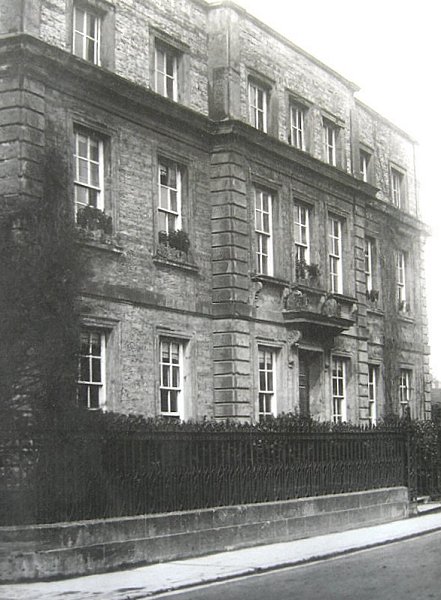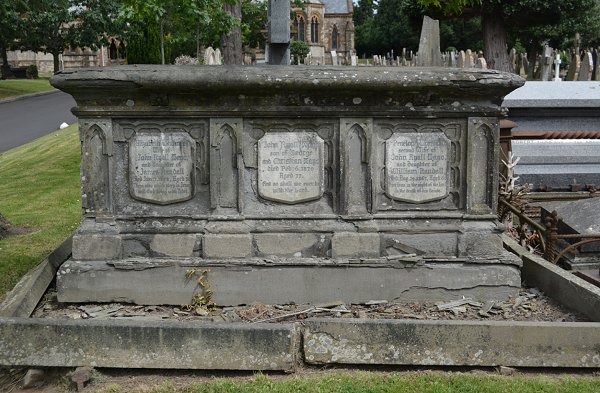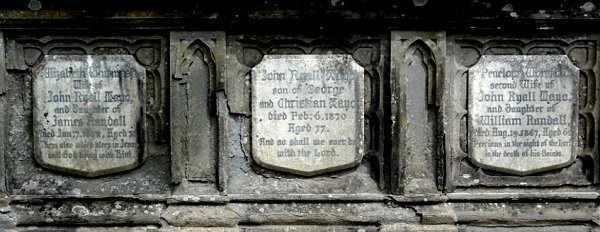yeovil people
john ryall mayo
Yeovil's first Mayor
 John
Ryall Mayo was
born on 31
December 1792 at
Nether Compton,
Dorset, and
baptised at St
Nicholas' church
there on 5
February 1783.
John
Ryall Mayo was
born on 31
December 1792 at
Nether Compton,
Dorset, and
baptised at St
Nicholas' church
there on 5
February 1783.
He was the son of yeoman farmer George Mayo (1760-1825) and his wife, Christian (1762-1826) who was the daughter of John Ryall. It was this John Ryall who was a wealthy glove manufacturer and owner of Old Sarum House that John would inherit.
In 1814 he married Elizabeth Whitmash Randall (1791-1822) and they had four children; John Ryall junior (1817-1899), Frances (1818-1819), Elizabeth Randall (1820-1892) and Katherine (1822-1917).
Elizabeth died in 1822 and in 1824 he married her cousin Penelope Worsfold Randall (1804-1867). They had five children; Mary Anne (1825-1889), George (1826-1832), William Henry (1826-1902), Thomas Worsfold (1829-1912) and James Randall (1830-1888).
In 1818 he inherited Old Sarum House on the corner of Park Road and Princes Street. In the 1841 census these were called Mayo’s Lane and Hendford respectively since the original Borough boundary had run along the centre of what is now called Princes Street, the buildings on the western side were known as being in Hendford.
Mayo's house was one of the properties attacked and damaged by the mob of hundreds of protesters in the Yeovil Reform Riot of Friday, 21 October 1831. The mob left after it was pointed out that Mayo was pro-Reform and it appears little damage was caused since he did not make a compensation claim. However, he instigated meetings the following January with the aim of forming a volunteer Yeovil Infantry Corps. Despite extensive searching it would appear that the Corps did not come to fruition.
In 1821 and 1822 he served as a Churchwarden of St John's church with Robert Tucker. Mayo was also a trustee of Woborn's Almshouse, John Mayo became a Surveyor of Highways and was. nominated, like his brother George, as a Town Improvement Commissioner. The two Mayo brothers, together with John Greenham (glove manufacturer, burgess and Portreeve in 1797) were exceptional in their work as Commissioners. After Greenham's death on 1838 John Ryall Mayo acted almost continuously as Chairman until the Commission ceased to exist when Yeovil became a municipal borough in 1854.
During 1837 he was one of the founders of the "Yeovil Coal and Potatoe Charity" with the intention of aiding the second poor of Yeovil.
In the 1841 census John Mayo was listed as of independent means aged 45, with his 35-year old second wife, Penelope, five children (Elizabeth and Katharine from his first marriage, Mary Anne, Thomas and James from his second marriage) and three servants.
John Ryall Mayo was an influential glove manufacturer and was listed as a subscriber to William Hull’s “History of the Glove Trade” in 1834. He was a member of the Vestry and also a Town Commissioner and his duties as Commissioner were very much involved with street widening and, as an example, he surrendered part of forecourt of his house, Old Sarum House, in Princes Street for that purpose.
In 1851, John was noted as an investor in the South Western Railway Company.
He became the first Mayor of Yeovil in 1854. Shortly afterwards the Lord Chancellor appointed Mayo, along with Frederick Greenham and William Bide, as Magistrates for the Borough.
In April 1862, John was listed among those subscribing to the new west window in St John's church in memory of Prince Albert. He subscribed £20 (around £2,200 at today's value).
He died in Old Sarum House on 6 February 1870 aged 77 and his death was reported in the Western Flying Post as follows "He was associated in business as a glove-manufacturer with his uncle, a Mr Ryall; he retired, however, about 30 or 35 years ago; and some time afterwards, in the establishment in the town of a branch of Stuckey's Banking Company; he became an extensive proprietor - an interest which he continue to hold until his death. He was one of the oldest and most esteemed inhabitants and was, for nearly half a century, intimately connected with the government of the town. He was recently almost the only surviving representative. That body was established nearly 50 years ago and for a lengthened period he acted with great acceptability as chairman."
His funeral expenses were recorded as £62 plus coffin £12 and lead lining £6 6s, mourning clothes £20. An inventory of his home valued the furniture and contents at £600 (around £500,000 at today's value), including 100 gallons of cider and bottles of port, Madeira and sherry. The poster advertising the sale of the house noted that it would be suitable for a hotel or school since it had 12 rooms, offices, stables and cottages.
He is buried in Yeovil Cemetery (see below) with his two wives and three of his daughters, the graves marked by a table tomb.

John Ryall Mayo's signature against the Vestry minutes of 29 December 1831.
Land Holdings
The Yeovil Tithe Apportionment of 1846 shows that George Mayo had extensive land holdings in Yeovil as tabulated below. His total acreage held in Yeovil was 26a 3r 37p.
| Owner | Occupier | No | Name |
| Mayo, John Ryall | Brooks, Joseph | 1332 | Great Ashley |
| Mayo, John Ryall | Brooks, Joseph | 1333 | Ashley Mead |
| Mayo, John Ryall | Brooks, Joseph | 1334 | Little Ashley |
| Mayo, John Ryall | Harrison, William | 1085 | Lower Nobles Nap |
| Mayo, John Ryall | Harrison, William | 1096 | Higher Nobles Nap |
| Mayo, John Ryall | Mayo, John Ryall | 265 | House & Garden (Old Sarum House) |
| Mayo, John Ryall | Mayo, John Ryall | 1050 | Higher Roping Path |
| Mayo, John Ryall | Mayo, John Ryall | 1052 | Lower Roping Path |
| Mayo, John Ryall | Mayo, John Ryall | 1053 | Cottage & Garden |
| Mayo, John Ryall | Mayo, John Ryall | 1054 | Orchard |
| Mayo, John Ryall | Mayo, John Ryall | 1406 | Higher Oxen Furlong |
gallery

Old Sarum House (now a dental practice) in Princes Street, home of John Ryall Mayo from 1818 until his death in 1870.

John Ryall Mayo's table tomb where he is buried with his two wives and three of his daughters. Photographed in 2014.

A closer view of the tomb inscriptions.